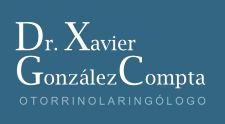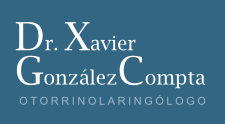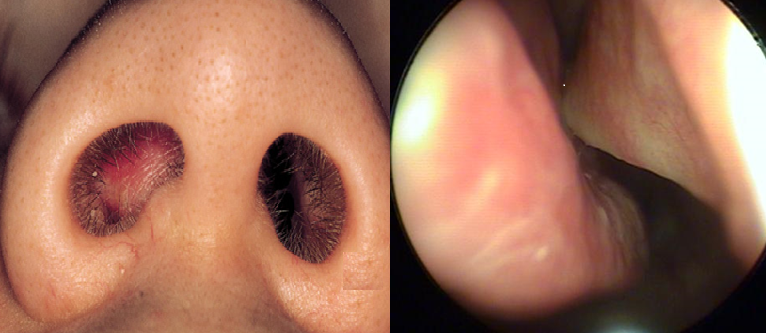Nasal breathing is important to get a good adaptation of the air entering our body. Nasal septal deviation tabique nasal, a structure of cartilage and bone that separates the two nostrils inside the nose, is the leading cause of adult nasal obstruction.
The consequences of nasal obstruction can be dry throat, headache, recurrent sinusitis, nosebleed, snoring, exhaustion to sport and even tooth malposition and alteration of smell.
Septal deviation is corrected by an intervention called Septoplasty. Septum surgery often is accompanied with turbinates surgery, nasal structures usefull to heat and humidify inspired air and excessively developed in cases of nasal deviation and in cases of chronic rhinitis.
Indication and alternatives to surgery
The only effective treatment for a deviated nose is septoplasty, since medical treatments can not modify the shape of the septum. However, if the deviation does not give a significant symptoms the patient may decide not to operate.
Sometimes it is necessary to make septoplasty to access the sinuses of the nose when the patient requires a Endoscopic sinus surgery.
Septoplasty is a functional surgery, which aims to improve nasal breathing. When you also want to modify the shape of the nose with an aesthetics purpose surgery is called Rhinoseptoplasty.
Preoperative
This surgery is usually done in a short stay unit, remaining few hours, based on patient characteristics and operation.
Usually performed under general anesthesia, so it is necessary to perform some preliminary preoperative tests. The patient must fast 6-8 hours before surgery.
Intervention
The duration of surgery is 30-60 minutes, although it may take longer depending on the complexity or other procedures such as cosmetic surgery are added.
Only a small incision is made to access the nose and septum is corrected. We currently use endoscopic surgery, laser, argon plasma, radiofrequency, absorbable staples (you do not need to remove) and other methods to improve the technical accuracy. After straightening the septum incision is closed with also resorbable stitches.
Usually both nostrils are plugged to reduce bleeding, but today we use reabsorbable sponges or plugs with sliding protection, that do not bother when removed. Also we should use special plastic into sheets to both sides of the wall to prevent the formation of abnormal scars.
In rhinoseptoplasty adhesive strips on nasal skin and a protective splint plaster can be placed, plastic or other materials.
Postoperative
The patient has a tamponated nose so it is not possible to breathe through the nose. Furthermore normal bleeding through the nose so gauze is placed “gauze in front of the nose” you can change many times as necessary.
After completing the anesthetic recovery patient is discharged with the necessary instructions regarding medication, repose, Cures, monitoring visit and emergencies.
The 3-4 early days the patient should not drink alcohol, smoke, make efforts neither drive. Relative rest is recommended at home, avoiding to blow the nose and make efforts. It is preferable to be sitting or semi-sitting for reducing blood pressure in the head, cephalic congestion and bleeding. It is also recommended to drink plenty of fluids and eat soft and cold during the first days due to the dry throat that causes nasal packing.
Although not a painful intervention, plugging causes frequent discomfort so different power antiinflammatory prescribed according to individual tolerance to pain and antibiotics to prevent secondary infection of mucus plugs retained by.
Nasal packing is removed in consultation with the 2-6 days, according to patient characteristics and intervention. If nasal sheets have been placed, should remain from 1 and 3 weeks. In rhinoseptoplasty the splint is usually changed at first week and is held for some weeks more.
It is normal a light bleeding during early 7-10 days and also nasal obstruction or congestion in the first weeks, crusts and nasal secretions, so are very important nasal washes. Are also normal some discomfort at the nasal tip and / or upper lip disappear progressively.
Normally you can return to normal activity in 1-2 weeks, but it is preferable to avoid exercise during 1 mounth.
The nose can take up 3 months to normalize after septoplasty and up 6-12 months rhinoseptoplasty. We recommend avoiding dusty, smoke pollution and to improve healing.
Risks and Complications
As all interventions and although they are generally low risk, septoplasty presents a number of risks that should be known before surgery.
- Scarring between the septum and nasal turbinates (sinechiae)
- Infection (sinusitis)
- Recurrence deviated septum
- Internal communication between both nostrils (perforation)
- Nosebleed (epistaxis)
There are other rare complications, such as the change in the external nasal form, loss of smell and / or taste, a fistula of cerebrospinal fluid or other anesthetic problems.



